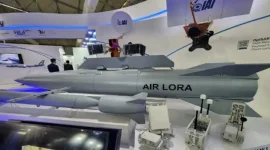- Views: 6K
- Replies: 9

The ongoing conflict in Ukraine has provided a stark demonstration of the strategic importance of advanced weaponry, with the SCALP air-launched cruise missile (ALCM) emerging as a game-changer.
Supplied by the UK and France, these long-range, precision-guided missiles have allowed Ukraine to strike high-value Russian targets far behind enemy lines, disrupting supply chains and degrading military capabilities.
This success story has important implications for India, highlighting the critical need for the nation to accelerate the development and deployment of its own indigenous cruise missiles.
The SCALP, with its impressive range and pinpoint accuracy, has proven instrumental in Ukraine's counteroffensive. Since their introduction in July 2023, these missiles have been used to neutralize key infrastructure such as bridges, command centers, and ammunition depots, significantly hindering Russia's ability to sustain its operations.
The SCALP's battlefield impact is comparable to that of other crucial systems like HIMARS, loitering munitions, and advanced air defense systems, all of which have contributed to shifting the momentum of the conflict.
For India, the SCALP's effectiveness in Ukraine serves as a powerful reminder of the need for self-reliance in critical military technology. Currently, the Indian Air Force (IAF) possesses only 36 Rafale fighter jets equipped to carry the SCALP, limiting its operational flexibility and overall strategic reach.
Furthermore, relying on foreign suppliers for such vital weapons systems creates vulnerabilities in supply chains and potential geopolitical constraints.
Recognizing this, India's Defence Research and Development Organisation (DRDO) and Hindustan Aeronautics Limited (HAL) have initiated indigenous cruise missile programs.
DRDO is developing a new stealth ALCM powered by a Small Turbofan Engine (STFE), designed to provide enhanced range, accuracy, and survivability. HAL, in collaboration with NewSpace Research & Technologies, is working on the CATS Hunter, a low-observable standoff missile optimized for integration with IAF fighter jets.
While these programs hold significant promise, their progress appears to have slowed. To ensure India's strategic autonomy and operational readiness, it is imperative to expedite the development and deployment of these indigenous cruise missiles. This will not only reduce reliance on foreign suppliers but also allow for customization to meet specific operational requirements.
Furthermore, domestic production will foster a robust defense industrial ecosystem, driving innovation in related technologies such as propulsion systems, stealth materials, and data links.
By prioritizing the development of indigenous cruise missiles like the DRDO stealth ALCM and the HAL CATS Hunter, India can significantly enhance its deterrent posture and operational capabilities.
These missiles, can be deployed on a wider range of IAF fighter aircraft, including the Su-30MKI and Tejas Mark 1A, will provide a crucial standoff capability, allowing India to project power and safeguard its national interests in an increasingly complex geopolitical landscape.




